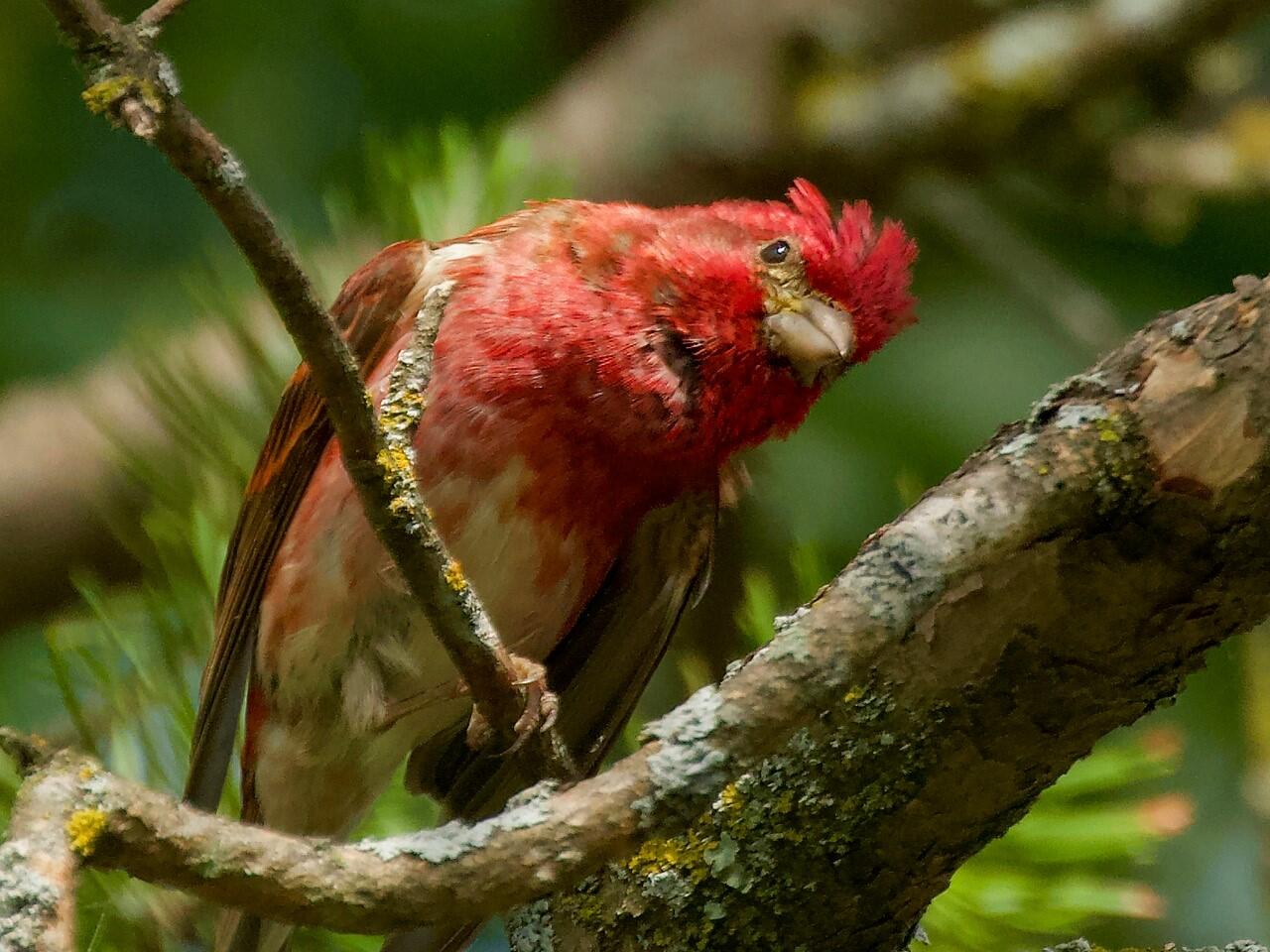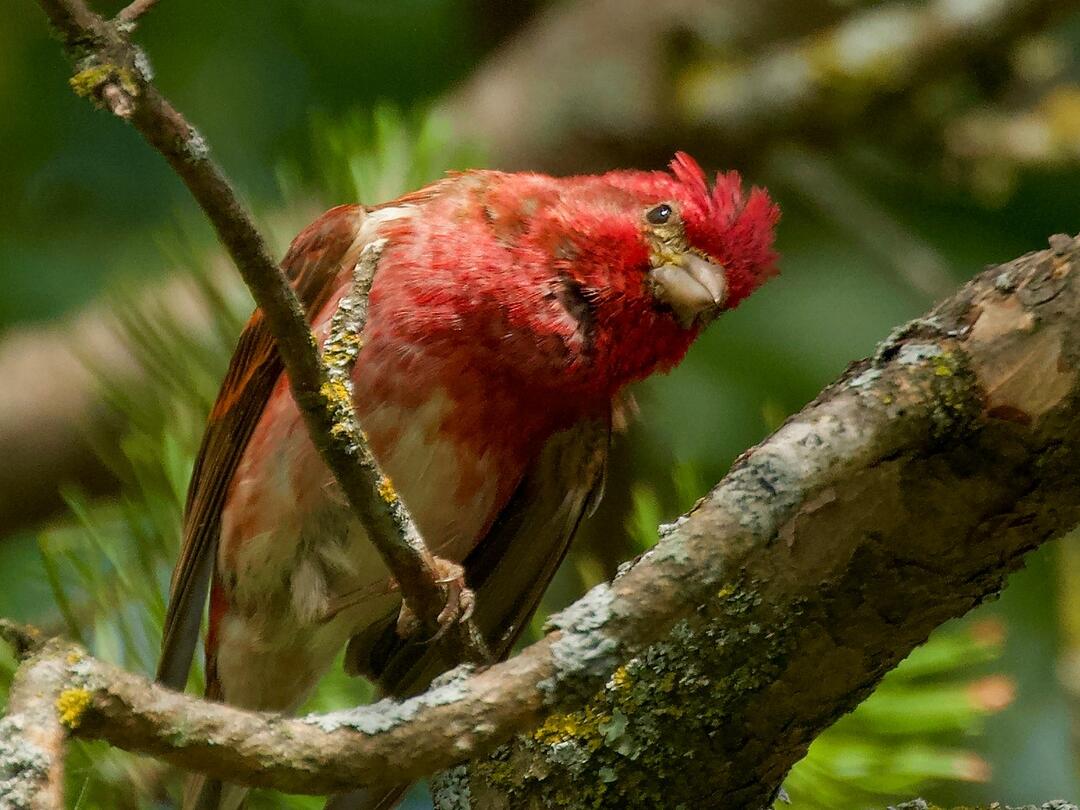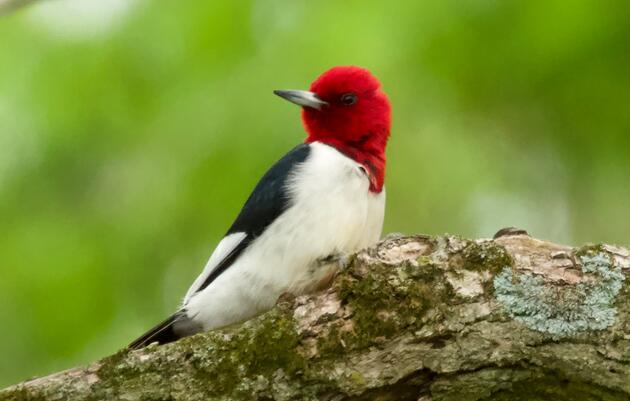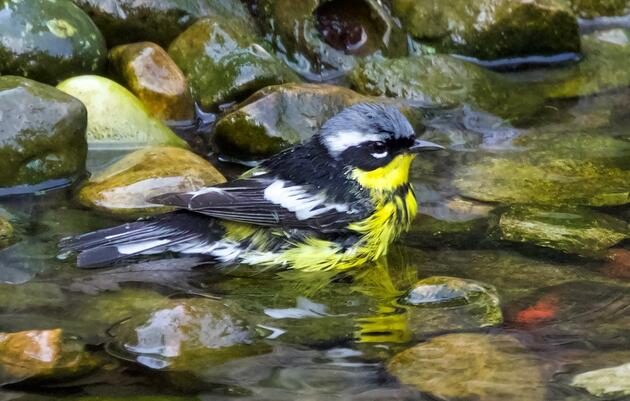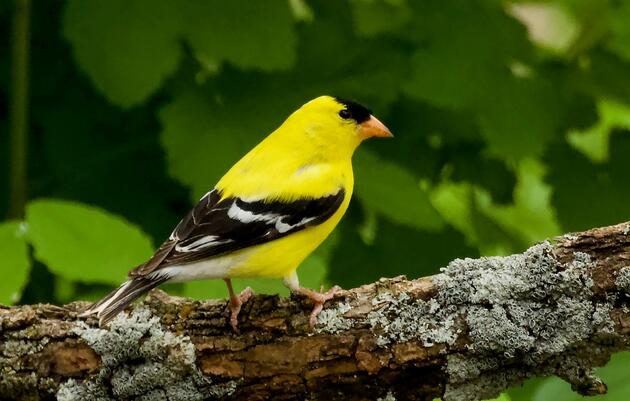By Tom Taylor, Resident Birder, Santa Fe, NM
For more than two months this column has taken you on a cyber-tour around the country during the spring songbird migration. This is the tenth and last column during the COVID-19 pandemic confinement. The reader can link to other articles in the series using the references at the bottom of this page. The tour began in the southwestern part of the US, where the author resides in Santa Fe, NM. For more than ten years each spring he has taken at least one photographic outing to another part of the country to follow the arrival of the neo-tropical migrants from Central and South America.
The previous column visited northeast Iowa and finished in the west-central part of Wisconsin near Necedah National Wildlife Refuge. This final article will return to New Mexico along a northerly loop from northwest Minnesota through the North Dakota prairie before quickly jumping to the southwest. I will take my first-person experiences from several birding excursions that covered those areas and distill them down to what I value most as the birding highlights. This last journey begins at Tamarac National Wildlife Refuge, about 50 miles east of Fargo, North Dakota. Just to the west of the refuge there is a marked transition from the northern forest to the Great Plains. A visitor at the park headquarters is guaranteed a close look at Purple Finches that visit the feeders there. This is a rare chance for someone from New Mexico as this finch has a very limited range in the western United States, which does not include the southwest. The refuge staff was puzzled at my attention to such a common bird – not realizing how it added to my collection of photos. For sure, the dedication paid off with a photo capturing the extraordinary raspberry-red brilliance of a male.
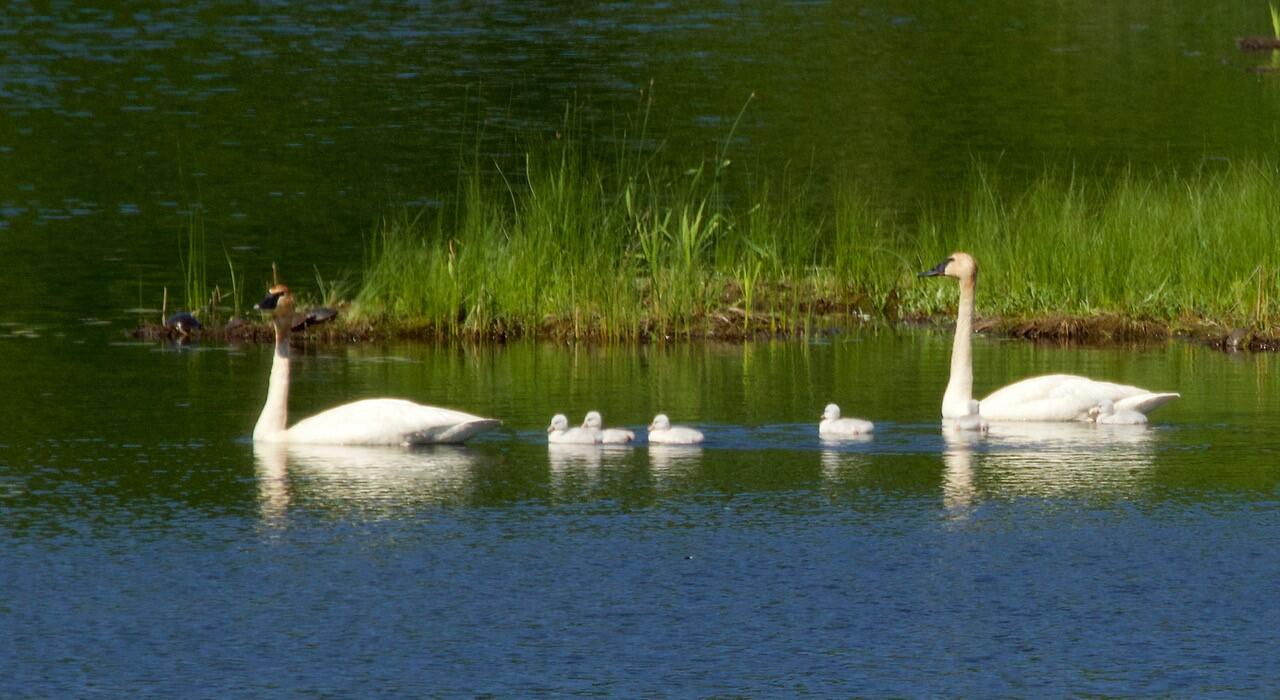
The refuge has played a key role in the return of the Trumpeter Swan to Minnesota, it having disappeared in the 1880s. Since the birds were reintroduced in 1987, their numbers have increased to several thousand, with more than 30 pairs nesting at the refuge. During my visit to the headquarters I was fortunate to see a nesting pair with seven cygnets in tow.
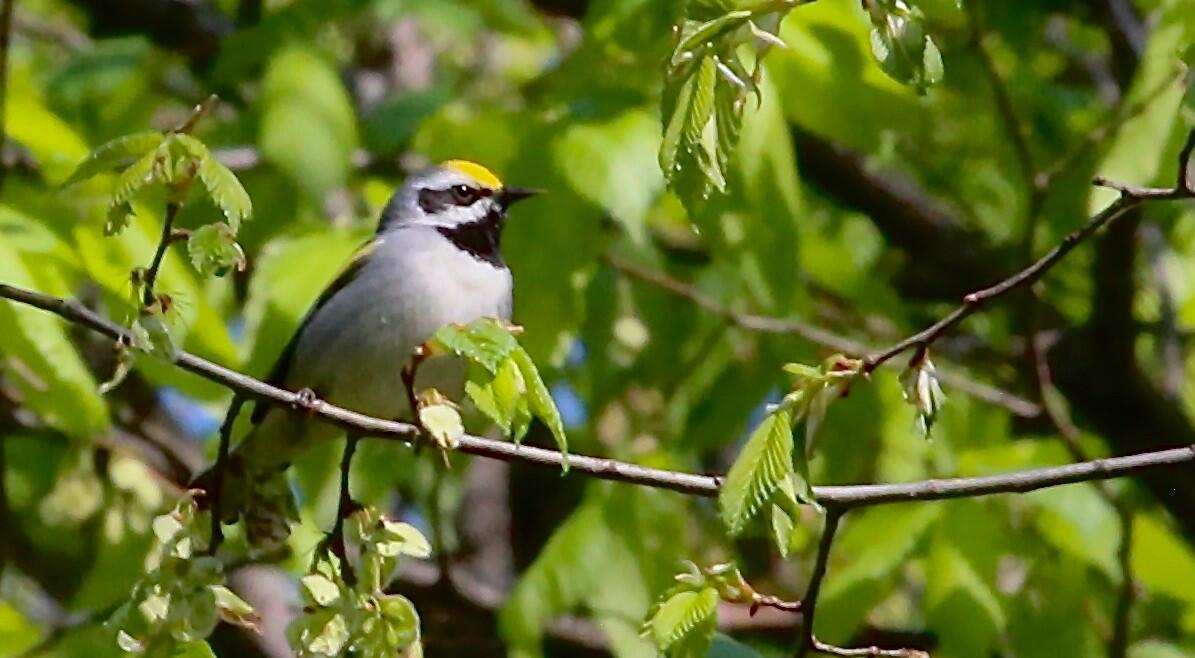
The refuge has also been involved in a restoration project to boost the population of Golden-winged Warblers, whose numbers have precipitously declined in the last 40 years. These birds, with prominent golden highlights in their wings and forehead, migrate from Central and South America. Currently Minnesota contains almost half of the bird’s nesting population. The refuge staff and other participants, such as the American Bird Conservancy, are pursuing an active habitat management plan to create a mixed ground cover where mature trees are not allowed to dominate the shrubby growth required by these birds.
Moving west from there the tour travels to the plains of North Dakota, which as seen in the photo can appear as a moving sea of grass highlighted by prairie flowers. The eastern half of the state consists of glaciated plains bounded on the west by the Missouri Coteau, which is an elevated moraine deposited parallel the Missouri River by the lower edge of glaciers during the last Ice Age. This resulted in a mixed geology in the state with large numbers of potholes and the random spread of erratic stones (see photo) across the vast plains.
The potholes in the coteau serve as breeding habitat for a multitude of waterfowl, while the plains support a wide assortment of grasslands birds, my main interest in this trip. (The erratic stones, so called “wandering’ rocks, have been randomly displaced from distant locations by the conveyor action of the glaciers over 10,000 years ago. I was really intrigued by the varied texture and colors produced when they were collected and used as building material, as seen for the stone house wall in Tuttle, North Dakota).
My birding experience in North Dakota is limited to the two times that I attended the Potholes and Prairie Birding Festival in Carrington during the first two weeks of June. The whole affair was well done – and most important for me the guides knew the territory and gave me a good chance to see the unique migratory sparrows nesting in the region. As you stand in the wide-open space, a chorus of sparrow song radiates from the grassy expanse – the one important factor in locating a perching subject. Very occasionally one of these smallish songsters would set up barely near enough to allow a less-than-optimal photo. Given this reality, I was quite pleased to have done as well as I did for the photos of the Baird’s and Nelson’s Sparrows.
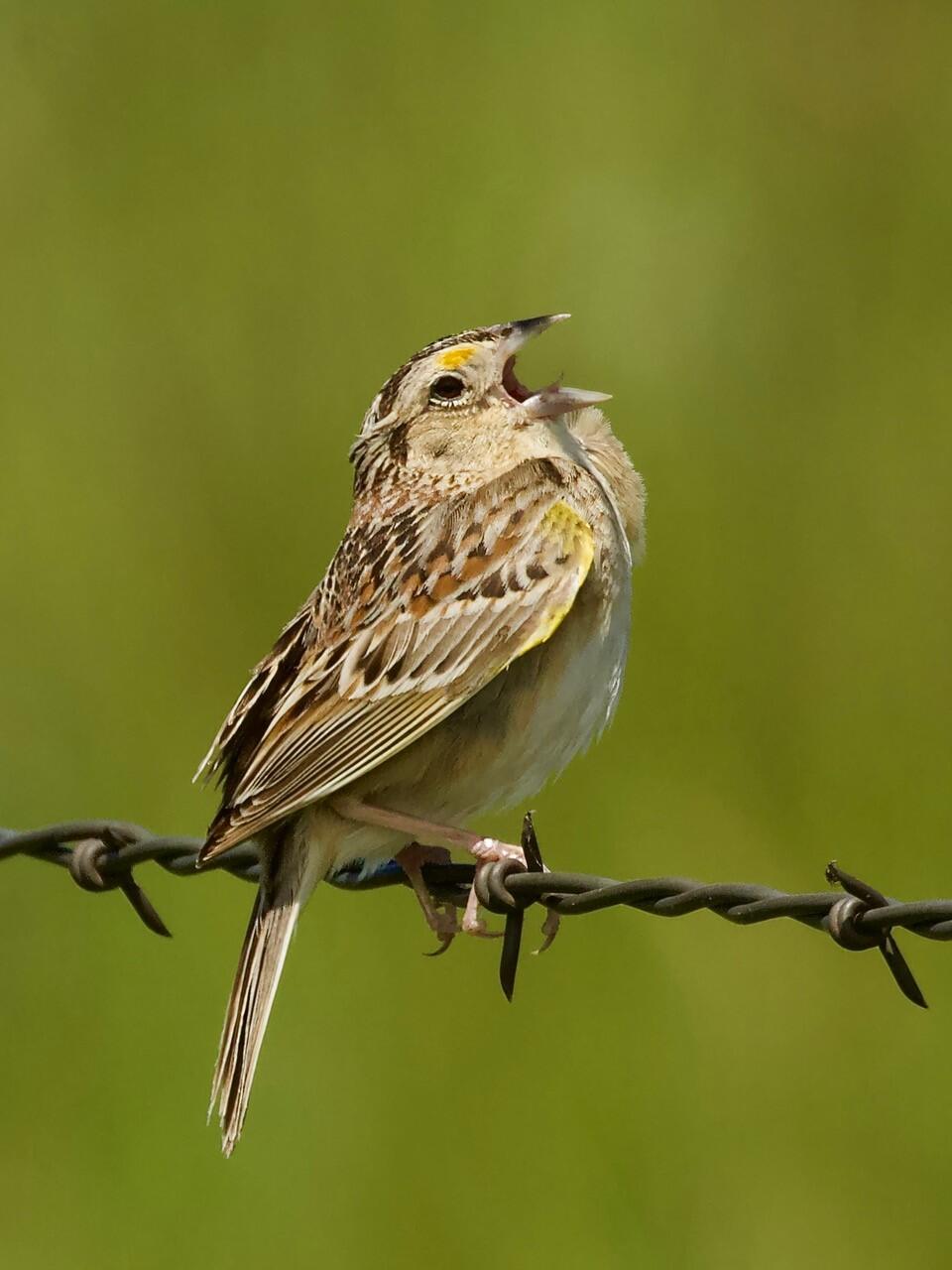
There are multiple other sparrow possibilities. But only the Grasshopper Sparrow had the grace to perfectly pose and sing while perched on a nearby barbed wire fence. (Barbed wire fences have been key to many of my successful sparrow photographs over the years). The photo clearly captures the easily obscured, somewhat yellow lores and edging in the wings. Fortunately, not all the birds were as hard to find as these sparrows. I found Bobolinks and Chestnut-collared Longspurs to be two such cases. They are very prominently found in the plains during the summer and fortunately have plumages and behave in ways that make them stand out more in the grasslands.
The Bobolink is in the blackbird and oriole family. In the spring the male’s creamed-colored cap sharply contrasts with its dark black “suit” and its long, bubbly meandering song gives you plenty of notice. The females have a much more sparrow-like appearance. It has an extraordinary migration path that takes it all the way to Argentina, well south of the equator. In the spring the male Chestnut-collared Longspur is one of the more colorful prairie species and a delight to see perched atop the shrubbery while singing its melody. As is the case for the Bobolink, they take on the more sparrow-like appearance of the female in the winter when they migrate to the southwestern part of the country and Mexico. (To experience the incredible variety of bird song in these grasslands, the reader should click the speaker icons where the birds are listed on the left side of this article).
There are a number of well-known refuges in the eastern half of North Dakota that have limitless waterfowl birding opportunities. Good stops can be had at Arrowwood and Chase Lake National Wildlife Refuges south of Carrington. However, an equally good location further west is Horsehead Lake near the town of Robinson in Kidder County. Rather than extending this article unduly before starting back to New Mexico, I will only show two of the nicer photos from there, hoping to encourage you to make a waterfowl-viewing visit someday. Both photos of the Black Tern and Willet give clear impressions of the birds in flight. In particular the Willet, which was nesting, shows the distinct white-highlighted wing pattern that is hidden when not in the air. But, even with this brief attention to wetlands, all is not lost in this context on the tour, as we make a last sweep across the state before leaving for New Mexico.
I want to first take the tour to place where I have had one of my most surprising birding successes – in the Turtle Mountains of North Dakota. Yes, mountains, at least for North Dakota. It is an area of forest, lakes and streams that extends 40 miles east to west and 20 miles north to south immediately below the border with Canada. A birder will do well to take the Turtle Mountain Scenic Byway that crosses this plateau that is 300 – 400 feet above the surrounding countryside. In my only visit there for a few hours I spotted a Common Loon, Broad-winged Hawk, Yellow-bellied Sapsucker, and took my first photos of the two grebes above. I must say, it was a miraculous day and one for which I owe thanks to a native Dakotan who recommended that I go there.
Finally, after a couple days drive south we conclude the cyber-tour in the Land of Enchantment and can begin sizing up the birding opportunities at home. In the present context of the confinement, we have only stretched our imagination in this 10-week long sojourn. But in reality, we can now start actually exploring our local birding haunts. And, it being the last half of June in New Mexico, we can soon expect to see both the Rufous and Calliope Hummingbirds at our feeders. The male Rufous will be in full force to upset the “social distancing” at our sweet buffet after returning from a nesting campaign in the northwest – with the females and youngsters to arrive a bit later. The male Calliope also will be in attendance – but a bit more polite. So, hats off to all the birds that helped make possible this cyber-tour.
In particular, I want to give a “shout out” to Stella Reed, at the Randall Davey Audubon Center & Sanctuary who has been the cyber-tour’s dedicated editor; and her volunteer assistant, Judy Kohn, who formatted the photos.
Moving on,
Tom Taylor

